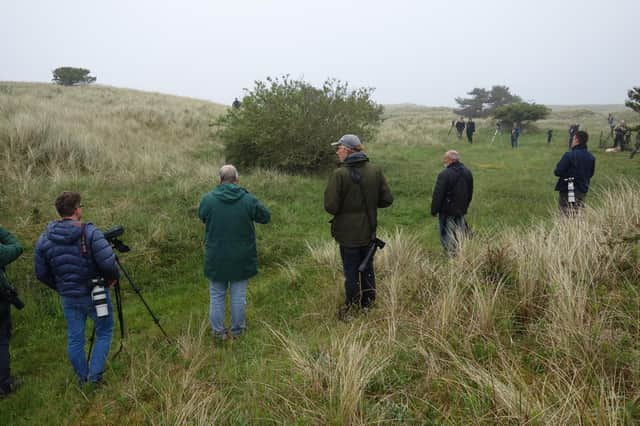NATURE NOTES:


As it was very skulking in thick bushes, he only managed some brief glimpses, but from these he thought it could possibly be a rare visitor from the Mediterranean region, a Subalpine Warbler.
Subalpine Warblers belong to the same family of warblers as our own Whitethroats and Blackcaps, but are much rarer, only being found in the county once every few years or so. A male ‘Subalp’ is a lovely small bird and a joy to behold, being a mixture of subtle slate blue grey shades above, and a salmon- terracotta tone below, all set off nicely with a short white ‘moustache’ and a red ring around the eye. Almost unmistakable, however, this individual was thought to be a female, as it seemed a much drabber looking thing on the very brief views obtained.
Advertisement
Hide AdAdvertisement
Hide AdOn hearing of this news, Mike, a birder from Newcastle who was doing some bird monitoring surveys in the Cheviots was keen to check this report out, so he headed down from the hills to the coast where he arrived on Holy island around lunchtime. Unfortunately there had been no further sign of the rare guest so he set about scouring the dunes and bushes in an attempt to relocate it.
Some birders, like me for example, would have looked for half an hour and if no sign would have moved on, but others are made of sterner stuff. It was only after 4 hours diligently hunting around without luck, he drifted off towards other parts of the island having given up. Still, something about this bird made Mike think it was sure to be still here somewhere, the fog was thick and the skies overcast, it couldn’t have flown in these conditions?
At about 6pm, Mike returned to see if the evening would bring about a change in the birds behaviour, after all most birds sing at dawn and dusk so if it was still around he might at least locate it by sound.
Another couple of hours passed, it was now 8pm and even a diligent observer like Mike was beginning to drag his feet, when just then, he spied a movement in a lone bush in the marrams. A twitching twig gave away the presence of something lurking among the leaves.
Advertisement
Hide AdAdvertisement
Hide AdAll of a sudden, a drab little bird popped out briefly. It looked odd. Just to be safe, he rattled off a few photographs and the bird dropped from view. In his words, his ‘heart missed a beat as I saw a drab warbler with... a yellow eye!’
Now you might have seen in my short description above of the Subalpine Warbler that I did not
mention a yellow eye? No, because it doesn’t have yellow eyes. Only one small, plain warbler has the combination of small size, sandy grey colour and bright yellow eye and that is a much, much rarer bird. A bird so rare it has not been seen well in the whole of the UK for twenty years.
Shaking, unbelievingly Mike checked the back of his camera to be sure his eyes had not deceived him and there it was, a total mega rarity of the highest order, an ASIAN DESERT WARBLER! This little bird should by now be lurking in the dry hot wadis of an Iraqi desert or even from as far away as Mongolia, not in a fog bound bush on the Northumberland coast, but here it was and it even began singing too.
Advertisement
Hide AdAdvertisement
Hide AdThe news of this amazing first for Northumberland and only the 13 th ever in the UK was soon made public and birders from all over the country were making plans to visit. A few of the fastest off the grid connected with it before dark on the same night but I had already had a glass of wine so prepared for the following morning.
Up bright and early at around 3.30am, gear packed, breakfast eaten and the half hour drive to Holy Island done, saw me parking up at 5am on the Snook. I was worried, thinking if it took Mike 7 hours, how on earth would we find this little bird? I needn’t have worried. The Asian Desert Warbler, Sylvia nana if you want its official title, was in full song to a small, socially distanced, appreciative crowd of 20 or so who had already driven overnight from as far away as London and Somerset.
Over the next 3 hours we managed some good views but the warbler was very shy at times, slowly creeping into the middle of thickly foliaged bushes and just sitting still for 20 minutes or more.
As I watched the bird, it dawned on me that if it wasn’t for lockdown, I should have been on holiday in Suffolk this week, so would not have seen it. At least this year my holiday cancellation has had one good feature. It continued to perform on a daily basis to steady stream of rarity pilgrims (Twitchers) all through the week, until it was finally seen around lunchtime on Friday, just ruining the weekend for those who could not make it on a weekday. It’s amazing how often that happens, it’s as if they knew.
I wonder where it is now?